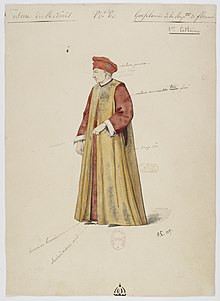
The Uffizi Gallery is a prominent art museum located adjacent to the Piazza della Signoria in the Historic Centre of Florence in the region of Tuscany, Italy. One of the most important Italian museums and the most visited, it is also one of the largest and best-known in the world and holds a collection of priceless works, particularly from the period of the Italian Renaissance.

Fabriano is a town and comune of Ancona province in the Italian region of the Marche, at 325 metres (1,066 ft) above sea level. It lies in the Esino valley 44 kilometres (27 mi) upstream and southwest of Jesi; and 15 kilometres (9 mi) east-northeast of Fossato di Vico and 36 kilometres (22 mi) east of Gubbio. Its location on the main highway and rail line from Umbria to the Adriatic make it a mid-sized regional center in the Apennines. Fabriano is the headquarters of the giant appliance maker Indesit.
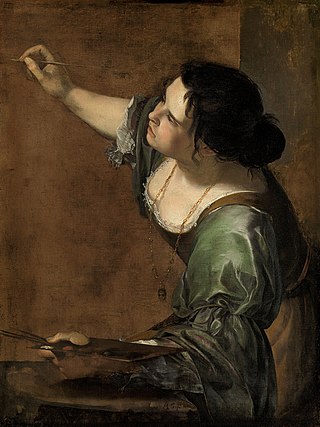
Artemisia Lomi or Artemisia Gentileschi was an Italian Baroque painter. Gentileschi is considered among the most accomplished 17th-century artists, initially working in the style of Caravaggio. She was producing professional work by the age of 15. In an era when women had few opportunities to pursue artistic training or work as professional artists, Gentileschi was the first woman to become a member of the Accademia di Arte del Disegno in Florence and she had an international clientele.

Agostino Tassi was an Italian landscape and seascape painter, and was convicted of raping Artemisia Gentileschi in 1612.

Giovanna Garzoni (1600–1670) was an Italian painter of the Baroque period. She began her career painting religious, mythological, and allegorical subjects but gained fame for her botanical subjects painted in tempera and watercolour. Her works were praised for their precision and balance and for the exactitude of the objects depicted. More recently, her paintings have been seen to have female bodily associations and proto-feminist sentiments. She combined objects very inventively, including Asian porcelain, exotic seashells, and botanical specimens. She was often called the Chaste Giovanna due to her vow to remain a virgin. Scholars have speculated Garzoni may have been influenced by fellow botanical painter Jacopo Ligozzi although details about Garzoni's training are unknown.
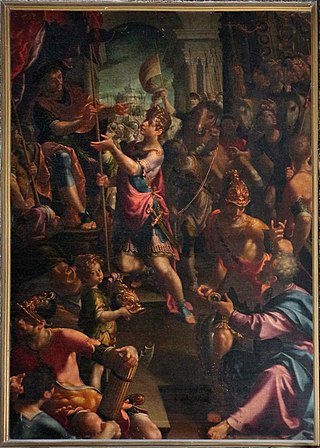
Aurelio Lomi was an Italian painter of the late-Renaissance and early-Baroque periods, active mainly in his native town of Pisa, Tuscany.
RidolfoII da Varano, signore di Camerino, was a condottiero operating in Italy from the 1360s. His forebears had long held the rocca of Varano on the borderland of the Papal States, controlling a major strategic pass between Umbria and the Marche, a link between Rome and the Adriatic coast. He inherited from Gentile di Berardo da Varano in 1355, and undertook the improvement of the fortifications that protected the commune and its rocca.

The Banner of the Holy Roman Church was the battle standard of the Papal States during the Renaissance and a symbol of the Catholic Church. The office of the Gonfalonier of the Church was originally intended to function as its bearer of the Holy See.
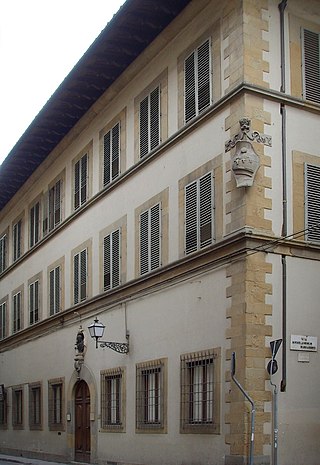
Casa Buonarroti is a museum in Florence, Italy that is situated on property owned by the sculptor Michelangelo that he left to his nephew, Leonardo Buonarroti. The complex of buildings was converted into a museum dedicated to the artist by his great nephew, Michelangelo Buonarroti the Younger. Its collections include two of Michelangelo's earliest marble sculptures, the Madonna of the Stairs and the Battle of the Centaurs. A ten-thousand book library includes the family archive and some of Michelangelo's letters and drawings. The Galleria is decorated with paintings commissioned by Buonarroti the Younger and was created by Artemisia Gentileschi and other early seventeenth-century Italian artists.
The Gonfalonier of the Church or Papal Gonfalonier was a military and political office of the Papal States. Originating from the use of the Papal banner during combat, the office later became largely ceremonial and political. At his nomination, the gonfalonier was given two banners, one with the arms of the Church and another with the arms of the reigning pope. The gonfalonier was entitled to include ecclesiastical emblems upon his own arms, usually only during his term of office but on occasion permanently. Pope Innocent XII ended the rank, along with the captaincy general, and replaced them both with the position of flag-bearer of the Holy Roman Church, which later became hereditary in the Naro Patrizi.
Arcangela Paladini was an Italian painter, singer and poet.

Self-Portrait as a Lute Player is one of many self-portrait paintings made by the Italian baroque artist Artemisia Gentileschi. It was created between 1615 and 1617 for the Medici family in Florence. Today, it hangs in the Wadsworth Atheneum Museum of Art, Hartford, Connecticut, US. It shows the artist posing as a lute player looking directly at the audience. The painting has symbolism in the headscarf and outfit that portray Gentileschi in a costume that resembles a Romani woman. Self-Portrait as a Lute Player has been interpreted as Gentileschi portraying herself as a knowledgeable musician, a self portrayal as a prostitute, and as a fictive expression of one aspect of her identity.

Self-Portrait as a Female Martyr, is also known as the Self-Portrait as a Martyr Saint. This painting was created by the Italian female artist, Artemisia Gentileschi. This self-portrait was made around 1615 depicting the artist herself as a martyr. It is one of two paintings by Gentileschi painted with oil on a wood panel. This self-portrait is currently in a private collection in the United States.
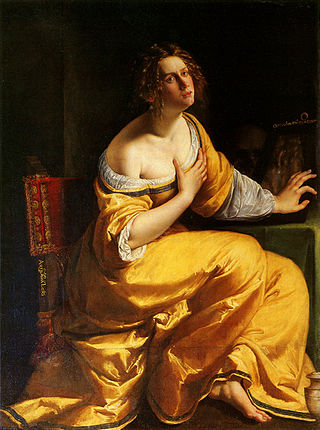
Penitent Magdalene is a 1616–1618 painting by the Italian baroque artist Artemisia Gentileschi. This painting hangs in the Pitti Palace in Florence. The subject is the biblical figure Mary Magdalene, but the painting references another biblical woman, Mary, the sister of Lazarus. This painting was likely painted during Gentileschi's Florentine period.

The Portrait of a Gonfaloniere is a painting by the Italian baroque artist Artemisia Gentileschi. It hangs in the Palazzo d'Accursio, Bologna. It is a portrait of an unknown gonfaloniere standing in full regalia and was painted in 1622. Mary D. Garrard has speculated that the man may be Pietro Gentile of Genoa.
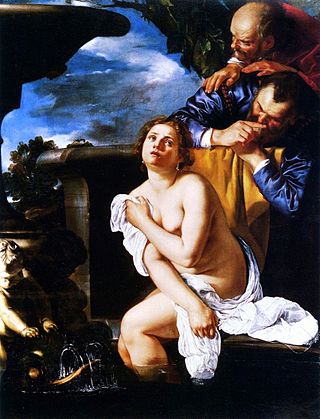
Susanna and the Elders is a painting by the Italian artist Artemisia Gentileschi. It is signed with Gentileschi's name and the date of 1622. The painting is in the collection at Burghley House near Stamford, Lincolnshire, England.

Lucretia is a painting by the Italian baroque artist Artemisia Gentileschi. It depicts Lucretia, the wife of Roman consul and general Collatinus, at the moment of her suicide. The decision to take her own life was made after she was blackmailed and raped by Sextus Tarquinius, a fellow soldier of Collatinus. It is one of a number of paintings of Gentileschi that focus on virtuous women ill-treated by men.

Cleopatra is a 1611-1612 oil on canvas painting of Cleopatra by Artemisia Gentileschi, now in the private Etro collection in Milan.
Marjorie Elizabeth Cropper is a British-born art historian with a special interest in Italian and French Renaissance and Baroque art and art literature. Dean of the National Gallery of Art’s Center for Advanced Study in the Visual Arts (CASVA) since December 2000, she previously held positions as Professor of Art History at Johns Hopkins University and director of the university’s Charles S. Singleton Center for Italian Studies at Villa Spelman in Florence.
